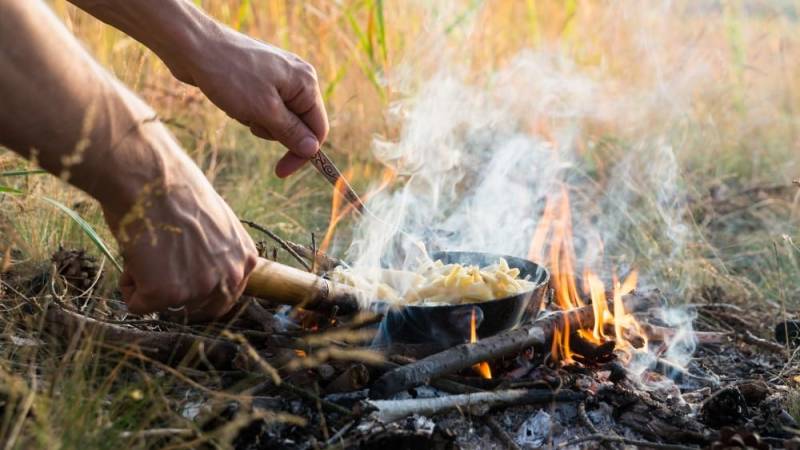
Fry food
Nomen
Meaning
Fry food is a cooking method commonly used in outdoor activities such as camping, hiking, and survival situations. It involves cooking food in hot oil or fat, typically in a frying pan or pot over an open fire or camp stove. This technique allows for quick and efficient cooking, as the high heat helps to seal in the flavors and create a crispy texture. Fry food is a popular choice among outdoor enthusiasts due to its versatility and ability to cook a wide range of ingredients, including meats, vegetables, and even desserts. It provides a convenient and delicious way to prepare meals in the wilderness.

Examples
„I love to fry food when I'm out in the wilderness. It's a great way to cook meat and vegetables quickly and add some delicious flavor to my meals.“
„When I go camping with my friends, we always take turns frying food over the campfire. It's a fun and social activity that brings us together and allows us to enjoy a tasty meal in nature.“
„One of my favorite things to fry is freshly caught fish. There's nothing quite like the taste of a crispy, golden-brown fish fillet cooked over an open fire. It's a true wilderness delicacy.“
„Frying food requires some basic equipment, like a cast iron skillet or a portable camping stove. It's important to have the right tools to ensure that your food cooks evenly and doesn't stick to the pan.“
„If you're new to frying food in the outdoors, start with simple recipes like fried eggs or bacon. Once you get the hang of it, you can experiment with more complex dishes and impress your fellow campers with your culinary skills.“
Origin
The word "fry" originates from the Old English word "frian," which means "to cook in hot fat." It has its roots in Germanic and Old Norse languages, where similar words were used to describe the cooking method of immersing food in hot oil or fat.
Over time, the word "fry" has evolved to encompass various cooking techniques, including shallow frying, deep frying, and pan frying. It has become a common term in culinary practices worldwide, referring to the process of cooking food in hot oil or fat until it becomes crispy and golden brown.
In the context of survival and bushcraft, frying food is a valuable skill to have. It allows you to cook and preserve perishable ingredients, such as meat and vegetables, by sealing in their flavors and extending their shelf life. Whether you're using a campfire, a portable stove, or improvised cooking methods, knowing how to fry food can provide you with nourishment and satisfaction in the wilderness.
Synonyms
Cook, Sauté, Pan-fry, Deep-fry, Stir-fry, Sear, Grill, Barbecue
Antonyms
Boil food, Steam food, Bake food, Roast food, Grill food, Sauté food, Simmer food, Stew food
Relatives
Cook food, Frying pan, Deep frying, Oil, Crispy, Golden brown, Temperature, Frying technique
Historical and cultural importance
Frying food has a long history and cultural significance in many different societies around the world. The act of frying food involves cooking it in hot oil or fat, resulting in a crispy and flavorful texture. This cooking method has been practiced for centuries and is deeply rooted in various culinary traditions.
In ancient civilizations such as the Egyptians, Greeks, and Romans, frying food was a common practice. They used different types of fats, including olive oil and animal fat, to fry a variety of ingredients. Frying was not only a way to cook food but also a preservation method, as the hot oil helped to seal in the flavors and extend the shelf life of certain foods.
In many Asian cultures, frying food is an integral part of their culinary heritage. From stir-fried dishes in Chinese cuisine to tempura in Japanese cuisine, frying plays a crucial role in creating delicious and visually appealing meals. The technique of deep-frying, where food is submerged in hot oil, is particularly popular in Asian cooking.
Furthermore, frying food has also gained cultural significance in Western societies. From French fries and fried chicken in the United States to fish and chips in the United Kingdom, fried food has become a staple in many traditional dishes. It is often associated with comfort food and indulgence, evoking feelings of nostalgia and satisfaction.
Overall, the historical and cultural relevance of frying food showcases its universal appeal and its ability to transform ingredients into delectable dishes. Whether it's for practical reasons or culinary enjoyment, frying food continues to be a popular cooking method across different cultures and time periods.
More information about the term Fry food
Fry Food
Frying food is a popular cooking method that involves submerging food in hot oil or fat. It is a versatile technique that can be used to cook a wide variety of ingredients, from vegetables and meats to desserts. In the world of survival and bushcraft, knowing how to fry food can be a valuable skill, as it allows you to transform basic ingredients into delicious and nourishing meals.
The Benefits of Frying Food
One of the main advantages of frying food is that it creates a crispy and flavorful exterior while keeping the inside moist and tender. This is especially important in survival situations, where you may be relying on limited ingredients and resources. Frying can help enhance the taste and texture of your meals, making them more enjoyable and satisfying.
Another benefit of frying food is that it can help preserve the nutritional value of certain ingredients. When food is fried quickly at high temperatures, it forms a protective barrier that seals in moisture and prevents the loss of vitamins and minerals. This can be particularly useful when cooking lean meats or vegetables, as it helps retain their natural goodness.
Choosing the Right Oil
When it comes to frying food, choosing the right oil is crucial. You want to select an oil with a high smoke point, which is the temperature at which the oil starts to break down and produce smoke. Oils with high smoke points, such as vegetable oil, canola oil, and peanut oil, are ideal for frying as they can withstand the high temperatures required for this cooking method.
It's also important to consider the flavor of the oil. Some oils, like olive oil or coconut oil, can add a distinct taste to the food. While this can be desirable in certain dishes, it may not always complement the flavors you're working with in a survival setting. In such cases, opting for a neutral-tasting oil is a safer choice.
Techniques for Frying Food
There are a few different techniques you can use to fry food, depending on the ingredients and equipment available to you. One common method is shallow frying, where the food is partially submerged in oil and cooked on both sides until golden brown. This technique works well for smaller pieces of food, like fish fillets or chicken wings.
Another technique is deep frying, which involves fully submerging the food in hot oil. This method is often used for larger items, such as french fries or doughnuts. Deep frying requires a deep pot or fryer and careful temperature control to ensure the food cooks evenly and doesn't become greasy.
Conclusion
Frying food is a valuable skill to have in the world of survival and bushcraft. It allows you to transform basic ingredients into delicious and nourishing meals, while also preserving their nutritional value. By choosing the right oil and using the appropriate frying techniques, you can create crispy and flavorful dishes that will keep you fueled and satisfied in the great outdoors.
Back to overview

